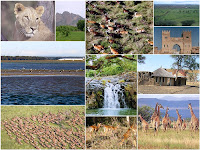The Shrinking Kenyan Forests
Kenya is fast losing its forests. Environmental organizations have warned that 'continued deforestation in Kenya will lead to severe consequences for the environment, affecting key production sectors if it proceeds at the current rate.' But is anybody listening?
 Without doubt, Kenya's rapid population growth rate, and most of all - poverty, are to blame for Kenya's widespread deforestation. Most people, being as poor as they are, cut trees as an alternative - to earn; the trees are turned in to charcoal or sold as timber. Pure greed is to blame, too; large tracts of land are being used for selfish economic gains. I wish more Kenyans, especially leaders, would heed Prof. Wangari Mathai's advice:
Without doubt, Kenya's rapid population growth rate, and most of all - poverty, are to blame for Kenya's widespread deforestation. Most people, being as poor as they are, cut trees as an alternative - to earn; the trees are turned in to charcoal or sold as timber. Pure greed is to blame, too; large tracts of land are being used for selfish economic gains. I wish more Kenyans, especially leaders, would heed Prof. Wangari Mathai's advice:
As she has pointed out before too: we humans need the trees to survive; the trees, don't need us. For us to survive, we have to preserve trees. At whatever cost. Otherwise, we are doomed. Kenya - magical, beautiful Kenya - has always been one of Africa's leading showcase for wildlife and nature. It is very sad to see vast tracts of forests being devastated; some being turned in to flower farms. Not only are forests being rapidly destroyed, but water and other natural resources too. The Greenbelt Movement has been doing wonders in trying to save Kenya's trees and in planting more trees; will the recent inauguration of the Kenya Forest Service Management Board help? Will it do and achieve the same as the Greenbelt? I very much hope so.
Above photo of Kenya's Kakamega forest from: flickr
 Without doubt, Kenya's rapid population growth rate, and most of all - poverty, are to blame for Kenya's widespread deforestation. Most people, being as poor as they are, cut trees as an alternative - to earn; the trees are turned in to charcoal or sold as timber. Pure greed is to blame, too; large tracts of land are being used for selfish economic gains. I wish more Kenyans, especially leaders, would heed Prof. Wangari Mathai's advice:
Without doubt, Kenya's rapid population growth rate, and most of all - poverty, are to blame for Kenya's widespread deforestation. Most people, being as poor as they are, cut trees as an alternative - to earn; the trees are turned in to charcoal or sold as timber. Pure greed is to blame, too; large tracts of land are being used for selfish economic gains. I wish more Kenyans, especially leaders, would heed Prof. Wangari Mathai's advice:Well most people know us as planters of trees. We started with planting of a tree in order to respond to the wood fuel crisis of the ‘80s, and the tree became both the symbol of what we were trying to do in healing the earth but also a symbol of what we can achieve because fortunately a tree grows very fast and because it is alive one develops a personal relationship with a tree, and so it’s a very powerful companion in this fight against environmental degradation. And most participants have planted trees on their own land to heal the soil, to provide themselves with the fruit trees, firewood, fodder for their animals.
And then the other very important program has been education. Until people understand the linkages between environmental degradation and their own problems, people become trapped, and they feel disempowered, they feel like they can’t do anything, they get overwhelmed by the problems.
As she has pointed out before too: we humans need the trees to survive; the trees, don't need us. For us to survive, we have to preserve trees. At whatever cost. Otherwise, we are doomed. Kenya - magical, beautiful Kenya - has always been one of Africa's leading showcase for wildlife and nature. It is very sad to see vast tracts of forests being devastated; some being turned in to flower farms. Not only are forests being rapidly destroyed, but water and other natural resources too. The Greenbelt Movement has been doing wonders in trying to save Kenya's trees and in planting more trees; will the recent inauguration of the Kenya Forest Service Management Board help? Will it do and achieve the same as the Greenbelt? I very much hope so.
Above photo of Kenya's Kakamega forest from: flickr


